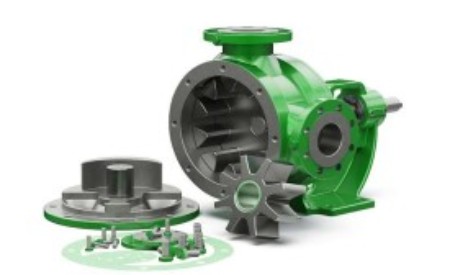

Home » Gear pump
External Gear Pumps
| Model | Max flow, m3/hr> | Max pressure, Bar | Viscosity range, cSt | Max speed (Rpm) | Max temperature (Deg c) |
|---|---|---|---|---|---|
| CMD 3/4 | 1.4 | 30 | 10 – 500 | 1500 | 100 |
| CMD 1 | 2.5 | 30 | 10 – 500 | 1500 | 100 |
| CMD 1-1/2 | 7.7 | 30 | 10 – 500 | 1500 | 100 |
| CMDY 1 | 3 | 12 | 10 – 500 | 1500 | 70 |
| CMDY 2 | 7 | 12 | 10 – 500 | 1500 | 70 |
External gear pump operating priciple:
Similar in operation to the Internal Eccentric Gear Pump, again with only 2 moving components within the process medium. The positive displacement of which is achieved by the filling of the cavities between the teeth of both gears located in the pump head. With each revolution, a fixed volume of fluid, enters the casing through the suction port, filling the space between the teeth of the gears. The process medium is then carried around the periphery or external areas of the gears until the casing is fully filled with the fluid and pushed out of the pump outlet under pressure. No fluid passes between the gears.
Fluid entering the pump:
The yellow coloured section in the image represents the process medium as it is entering the pump suction port, pump casing & filling the cavities between Gears. The 3 arrows indicate the direction of fluid passage through the pump and rotational direction of the gears.
Fluid filling the cavities between the teeth of the gears & casing:
As the fluid progresses through the pump head and fills the cavities between the gears i is carried around the outside of the gears filling the casing at the top and bottom
Pump is flooded & starts to discharge the process medium under pressure:
Once the pump is fully flooded, the driving gear (Top) and driven gear (Bottom) form a liquid seal thanks to their intermeshing teeth, which then enables the fluid to exit the discharge of the pump under pressure. The delivery pressure is dependent on the installed power of the motor
